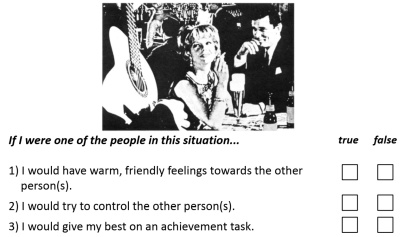Self-report and grid motive measures are measures of explicit motives and should not be used in tests of theories about implicit motives
|
In a recent commentary about a paper in which an author team examined the role of power motivation in anorexia based on McClelland’s and Winter’s theory of implicit power motivation, but used a grid self-report measure to test hypotheses, Oliver Schultheiss (2021) emphasized that grid-type measures, such as the Multi-Motive Grid (MMG), do not assess implicit motives. They therefore do not allow to test hypotheses based on McClelland’s motivation theory, which was built upon findings obtained with picture-story motive measures of implicit motives, which McClelland and others were always careful to set apart from the motivational needs that people ascribe to themselves and that are termed explicit motives. Schultheiss points out that grid-type measures:
|

An example of a grid-type explicit motive measure from Schultheiss et al (2009)
|
1. Were never validated based on the fundamental validity criterion for motive measures; that is, it has never been systematically demonstrated that scores obtained with grid measures vary as a function of experimentally varied motivational states;
2. Do not substantially correlate with picture-story motive measures; that is with measures that were validated according to the experimental-variation criterion
3. Correlate substantially with other motive measures based on self-report.
The same arguments also apply to standard questionnaire measures of motivational dispositions. However, to this day researchers frequently ignore the fundamental difference between picture-story measures of implicit motives and self-report/grid measures of explicit motives and use the latter to test theories about the former (see, or instance, here, here, here, here, or here). This leads to a situation of Babylonic confusion, because corroborations and refutations resulting from such studies are meaningless for motivation theory built on picture-story motive measures, and it is hard to make sense of the resulting research literature. In his paper, Schultheiss therefore strongly urges researchers to exercise greater care when matching their theorizing to the motive measures they employ |
Power-motivated people avoid angry faces
Are women more verbally fluent than men?
Discovery of a potential new indicator of pubertal hormone levels linked to human power motivation
What motivates you as an adult may depend on the hormones you were exposed to as a fetus
David Winter presents talk on the roots of war
Competition, aggression, and hormones
Women are more affiliation-motivated than men
Why the power-motivated are better at parking their cars
New meta-analysis: Low to no correlation between implicit and explicit motive measures
Content-coding motive measures can be approcimated with automated word counts
Exploiting the full potential of thematic apperception through profile analysis
High progesterone is associated with less coherent brains (August 2012)
What color naming speed reveals about the wisdom of
one's goal choices (December 2010)
Are you high on testosterone and is that a good thing? Listen to Podcast of interview with Dr. Oliver Schultheiss on UM NewsService
New edited book on implicit motives available (October 2009)
What the word "not" may reveal about your ability to handle stress (October 2008)
Estrogen fuels female power (February 2008)
High-testosterone people reinforced by others’ anger, new study finds (February 2007)
Study finds US students more motivated to achieve, less power-hungry than German students (August 2006)
Are all people stressed out by a defeat or does it hurt some more than others? (April 2006)
|

